Notes For All Chapters Biology Class 11 CBSE
There are over a million species of animals that have been described till now. These vast species have diverse structural forms. Therefore, the need for classification of animals becomes very important.
1. Animals : Features & Basis of Classification
The classification helps in easy identification and also in assigning a systematic position to newly described species.
In spite of differences in structure and form of different animals, there are fundamental features common to various individuals in relation to the arrangement of cells, body symmetry, nature of coelom, patterns of digestive, circulatory or reproductive systems. These features are used as the basis of animal classification.
Levels of Organisation
All members of Animalia are multicellular, heterotrophic eukaryotes. But, all of them do not exhibit the same pattern of organisation of cells. The cells in their body are of several types. These are organised into several functional units of progressively increasing complexity.
The animal body shows four basic levels of structural organisation as given below
1. Cellular Level
In this level, the body shows some division of labour among cells. They are remarkably independent and can change their form and function. It is found in sponges. The body consists of many cells arranged as loose cell aggregates but, the cells do not form tissues.
2. Tissue Level
Here, in coelenterates, the arrangement of cells is more complex. The cells performing the same function are arranged into tissues, hence is called tissue level of organisation.
3. Organ Level
In Platyhelminthes and other higher phyla, tissues are grouped together to form organs, each specialised for a particular function, i.e., organ level organisation is present.
4. Organ System Levet
In animals like annelids, arthropods, molluscs, echinoderms and chordates, organs have associated to form functional systems, each system concerned with a specific physiological function. This is called organ system level of organisation. Organ systems in different groups of animals exhibit various patterns of complexities.
Like the digestive system in Platyhelminthes has only a single opening to the outside of the body that serves as both mouth and anus and is thus, called incomplete.
A complete digestive system has two openings, i.e., mouth and anus.
Symmetry
The symmetry refers to the arrangement of parts on the opposite sides of the body of a three dimensional animal.
On the basis of symmetry, animals can be of following types
1. Asymmetrical
Animals in which, any plane passes through the center does not divide them into equal halves such animals are called asymmetrical, e.g., Sponges.
2. Symmetrical
The body of some animals can be divided into two similar equal halves by one or more planes. Such animals are called symmetrical.
The symmetry can be further divided as
i. Radial Symmetry
When any plane passing through the central axis of the body divides the organism into two identical halves, it is called radial symmetry, e.g., Coelenterates, ctenophores and echinoderms.
ii. Bilateral Symmetry
In some animals, body can be divided into identical left and right halves in only one plane. This is called bilateral symmetry, e.g., Annelids, arthropods, etc.
Diploblastic and Triploblastic Organisation
Germ layers are group of cells behaving as a unit during early stages of embryonic development. It differentiate to give rise to all the tissues/organs of the fully formed individuals.
On the basis of germ layers animals are classified as follows
1. Diploblastic
Animals in which the cells are arranged in two embryonic layers—an external ectoderm and an internal endoderm, are called diploblastic animals. In addition, an undifferentiated layer, mesoglea is present in between the ectoderm and the endoderm. e.g., Coelenterates.
2. Triploblastic
The animals in which the developing embryo has a third germinal layer mesoderm, in between the ectoderm and endoderm are called triploblastic animals, e.g., All animals from phylum-Platyhelminthes to phylum-Chordata.
Coelom
The body cavity (between the body wall and gut wall) which is lined by mesoderm is called coelom. The presence or absence of coelom is very important in classification. On the basis of coelom, animals can be classified in three different groups
1. Acoelomates
The animals in which the body cavity is absent are called acoelomates, e.g., Poriferans, platyhelminthes, coelenterates, ctenophors and flatworms.
2. Pseudocoelomates
In some animals, the body cavity is not lined by mesoderm. Instead, the mesoderm is present as scattered pouches in between the ectoderm and endoderm. Such a . body cavity is called pseudocoelom and the animals possessing them are called pseudocoelomates, e.g., Aschelminthes.
3. Coelomates
The animals having true coelom are called coelomates. A true coelom arises within mesoderm and is therefore, lined by mesodermal tissues, i.e., externally by parietal peritoneum and internally by visceral peritoneum.
Body Plan
Animals have three types of body plans. These are
Segmentation
In some animals, the body is externally and internally divided into segments or somites with a serial repetition of at least some organs.
Segmentation can be of following two types
1. Metameric Segmentation
A segmentation that simultaneously divides body both externally and internally is called metamerism or metameric segmentation. This kind of segmentation is found in annelids, arthropods and chordates.
2. Pseudometamerism
It is found in tapeworm, the body is divisible into parts or segments called proglottides. They develop from the neck but are not embryonic in or T n r a repetition which appears due to repeated budding As known as false segmentation or pseudometamerism.
Notochord
It is a mesodermally derived rod-like structure formed on the dorsal side during embryonic development in some animals.
Animals with notochord are called chordates and those animals which do not form this structure are called non-chordates, e.g., Porifera to echinoderms.
Other Important Features
Apart from the basic features of body, size and shape, animals also possess some other important features too. Some of them are given below
1. Cephalisation
It is the differentiation of head in anterior part of the body. It involves the concentration of nervous tissue and sense organs in the head.
2. Appendages
The projecting structures of the body that perform specific functions like locomotion, capturing of food, sensation, etc., are called appendages, eg., Wings, fins, limbs, tentacles, parapodia, setae, etc.
3. Digestive System
Digestive tract is the passage through which food is taken for digestion, absorption and egestion. The digestive tract that has a single opening for both ingestion and egestion is called incomplete digestive tract, eg., in flatwprms and coelenterates.
The digestive tract with two external openings, one for ingestion and other for egestion is called complete digestive tract. It is present in aschelminthes and higher animals.
4. Respiratory System
Respiration occurs in different ways in different animals
(i) The tiny aquatic animals like Amoeba, Hydra, etc., respire through the body surface. This is called body surface respiration.
(ii) Larger aquatic animals have special organs called gills for respiration. This is called branchial respiration, eg., In prawns, fishes and mussels.
(iii) The land animals respire through lungs. This is called pulmonary respiration. It occurs in frogs, snails, lizards, birds and mammals.
(iv) Insects have tracheal respiration, which occurs through trachea i.e. an intercommunicating tubes through which gas exchange occurs.
(v) In animals like earthworm, leech, frogs etc., moist skin acts as respiratory surface. This is called cutaneous respiration.
(vi) Scorpions have book lungs and king crabs have book gills for respiration.
(vii) In frog, gas exchange also occurs through the lining of buccopharyngeal cavity. Hence, called buccopharyngeal respiration.
Frogs have three modes of respiration, i. e., Cutaneous, buccopharyngeal and pulmonary.
5. Circulatory System
The circulatory system is responsible for the transport of materials in the body. It consists of a fluid (called blood) blood vessels and a heart.
The circulatory system is closed when blood flows within the blood vessels.
If blood flows in spaces, and the sinuses are without proper boundries, the circulatory system is called open. In insects such as prawn and Pila, blood is colourless that contains haemocyanin (a copper containing pigment) while, in vertebrates, blood contains haemoglobin (an iron-containing pigment).
6. Excretory System
Excretory system is involved in the removal of nitrogenous waste products from the body of an organism with the help of excretory organs.
The excretion occurs in different ways in different organisms. Such as
(i) The excretory organs are absent in those organisms where organisation level is below the tissue level. Here, each individual cell takes part in excretion.
(ii) In animals like sponges, coelenterates, all the cells are in contact with water. Excretion occur by general body surface.
(iii) In vertebrates, kidneys are the excretory organs. Based on excretory products animals can be classified into four categories as given below
(i) Aminotelic, excretory product is amino acids, e.g., Starfish, Unio,’etc.
(ii) Ammonotelic, excretory product is ammonia, e.g, most invertebrates and some molluscs.
(iii) Ureotelic, excretory product is urea, e.g., Cartilaginous fishes, snail, prawn, mammals and aquatic reptiles.
(iv) Uricotelic, excretory product is uric acid, e.g, Insects, terrestrial crustaceans, lizards, snakes, birds etc.
7. Nervous System
The nervous system is the aggregation of nerve cells that help in coordinating and controlling various activities of the body.
8. Endocrine System
The endocrine glands are also called ductless glands. These secrete hormones. Endocrine glands occur in all vertebrates and in some invertebrates (like insects).
9. Sensory System
This system consists of specialised cells, tissues and organs which can pick up a stimulus and transmit the same to the nervous system.
Sensory system consists of different structures in different organisms, e.g., Antennal (tactile and smell), tentacles (tactile), skin (tactile), statocyst (balancing), ear (hearing), olfactory epithelium (smell), taste buds (taste), eyes (vision), lateral line organs (current receptors), etc.
10. Skeletal System
Skeletal system is a hard, internal or external framework • that provides support and shape to the body. Some animals which are devoid of a skeleton have soft body, e.g., Platyhelminthes, aschelminthes, annelida.
Skeleton system can be of following types
i. Exoskeleton
It is the hard supporting and protective framework present on exterior of the body. It is made of non-living matter, e.g., External shells of molluscs, cuticle of arthropods, scales of fishes and reptiles, feathers of birds, hair, hoofs, nails, horns and claws of mammals.
ii. Endoskeleton
It is a hard supporting framework present in the interior of the body. In invertebrates such as sponges, it is made up of calcareous or siliceous spicules. In vertebrates, it is composed of hard living tissues called cartilages and bones. Endoskeleton supports whole body of an organism.
Note:
* Nervous system was first formed in cnidarians.
* Ascaris and earthworm are both ammonotelic and ureotelic.
* Development of living and growing endoskeleton in vertebrates has enabled them to attain large size.
11. Sex
Animals generally have sex organs to produce sexual reproduction. When both male and female sex organs are found in some individual, it is called hermaphrodite or bisexual or monoecious, e.g, Liver fluke, tapeworm, earthworm, leech, etc.
The animals with either female or male sex organ is known as unisexual or dioecious, e.g., Frog, lizards, birds, dog, etc. When male and female can be distinguished on the basis of external features, the condition is called sexual dimorphism, e.g., Lion and lioness, man and women, peacock and peahen, etc.
12. Reproduction
Reproduction in organisms can be either asexual or sexual.
i- Asexual Reproduction
This kind of reproduction does not involve fusion of gametes. It is found in lower animals like sponges, coelenterates, annelids, platyhelminthes. The common methods are budding, fission, fragmentation and regeneration.
ii- Sexual Reproduction
It involves formation and fusion of gametes. The male gametes called sperms are motile while, the female gametes called ova are generally non-motile.
13. Fertilisation
Fertilisation in animals is of two types
i. External Fertilisation
Animals such as many invertebrates, some marine fishes and most amphibians, shed both eggs and sperms into water, where fertilisation and development occur. This is called external fertilisation.
ii. Internal Fertilisation
In land animals and some aquatic animals, the sperms are introduced by the male into reproductive tract of female during copulation. This is called internal fertilisation.
Fertilisation occurs in the genital organs of the female.
Oviparous and Viviparous Animals
All the animals with external fertilisation and many with internal fertilisation, such as reptiles and birds, lay eggs. They are called oviparous animals.
Some animals with internal fertilisation give birth to young ones.
Such animals are of two typesOvoviviparous animals produce large, heavily yolky eggs that develop in the reproductive tract of the mother without deriving nourishment from her, e.g., Rattle snake, sharks, etc.
Viviparous animals produce minute eggs and the embryos are nourished during development in the mother’s genital tract, e.g., Mammals.
In oviparous animals the newly hatched young one, may resemble the adult. This kind of development is called direct development. In some animals, the young hatching from eggs do not resemble the adult. These are called larvae or nymph.
larvae lead independent life for sometime and later undergo important changes to become adults. These changes from larvae to adults are called metamorphosis. This kind of development is called indirect development.2. Non-Chordata
The animal kingdom includes about 35 phyla, of which 11 are considered as major phyla. Animals can be classified in two major groups on the basis of presence or absence of notochord. They are
(i) Non-chordata (absence of notochord)
(ii) Chordata (presence of notochord)
They can also be classified on the basis of presence or absence of vertebral column (backbone) into
(i) Invertebrates (without backbone)
(ii) Vertebrates (with backbone)
The Non-chordata includes the following phylums(hPhylum Porifera)
Phylum—Porifera (Porous — pore; ferre — to bear) includes the first and the most primitive group of multicellular animals, referred to as poriferans, i.e., pore bearing animals. They are primitive, multicellular animals and are commonly called sponges.
General Features
Some general features of phylum-Porifera are discussed below
i. Habitat They are mostly marine and some are freshwater habitat, found in ponds” and lakes, e.g., Spongilla.
The study of poriferans is called Parazoology. Even though they are multicellular, they do not have tissue grade of organisation.
ii. Shape and Size The size of sponges ranges from 1 cm to 1 m in length. Some of them have vase like cylindrical shape and majority have irregular shape.
iii. Symmetry The cylindrical form (e.g., Sycon) show radial symmetry while, sponges showing irregular shape and have no symmetry.
iv. Body Wall The body wall contains outer dermal layer or pinacoderm and inner gastral layer or choanoderm.
* The pinacoderm contains flat cells called pinacocytes.
* The choanoderm consists of spherical cells with collar from which a flagllum emerges out. Hence, they are also called flagellated cells or collar cells.
v. Body Organisation Sponges show cellular level of organisation. The cells are almost independent, i.e., cooperating very little with one another in function.
vi. Germ Layers These are diploblastic.
vii. Body Cavty The sponges have a large cavity called spongocoel or paragastric cavity. It opens to the outside by a terminal opening called osculum.
viii. Skeleton It is internal and includes inorganic spicules and organic spongin fibres.
ix. Canal System It is one of the most important feature of sponges. Canal system is the network of channels called canals, which connect the spongocoel to the outside through ostia. The canals are lined by choanocytes. It maintains a constant flow of water from ostia to osculum through spongocoel. It helps in nutrition, respiration, reproduction and excretion.
The canal system is the lifeline of the sponges.
x. Digestion Digestion in animals of this phylum is intracellular (inside collar cells) in nature.
xi. Circulation The amoeboid cells transport food from ingesting cells to other cells.
xii. Respiration It occurs through the body surface by diffusion.
xiii. Excretion It also occurs through the body surface by diffusion in the form of ammonia.
xiv. Sensory System Sponges lack sensory and nerve cells, so they are poor in response to stimuli.
xv. Reproduction Sponges reproduce both asexually and sexually. Asexual reproduction occurs by budding or gemmules or internal buds.
Sexual reproduction involves the fusion of ova and spermatozoa.
xvi. Fertilisation and Development
Fertilisation is internal i.e., sperms of one sponge are carried by water current to the ova of another sponge for in situ fertilisation. Development is mostly indirect with larval stages called parenchymula (Leucosolenia) or amphiblastula(Sycon).
Class Common Name of Some Sponges
2. Dhylum Coetentcrata (Cnidana)
There are about 9000 species of cnidarians. The name Cnidaria (Knide — nettle or sting cells) is derived from the stinging cell or cnidoblasts present on the ectoderm of tentacles and body of these animals.
General Features
Some important general features of phylum coelen- terata are discussed below
i. Habit and Habitat Cnidarians are exclusively of marine forms (Obelia, Aurelia, Physalia, Metridium), but few of them are freshwater form (e.g. Hydra). They are either sedentary (fixed) or free swimming forms.
ii.Body Organisation and Body Wall They have tissue grade organisation. Coelenterates are diploblastic. The layers of body wall contain several types of cells, such as interestitial cells, sensory cells, nerve cells, epitheliomuscular cells, stinging cells (cnidoblasts), etc.
iii. Coelentric Cavity A coelenteron or gastro- vascular cavity is present, which is blind at one end and opens as mouth or hypostome at other end. Mouth is used both for ingestion and egestion.
iv. Tentacles The mouth is surrounded by many thin, long, slender hollow structures called tentacles. Their function is to paralyse and capture the prey, attachment, defense and offence.
v. Skeleton A horny or calcareous exoskeleton as well as endoskeleton is present in many cases. The coelenterate with exoskeleton of calcium carbonate are called corals.
vi. Digestion In coelenteron or gastrovascular cavity, both intracellular and extracellular digestion occurs.
vii. Respiration and Excretion Exchange of gases and excretion occurs directly as all the cells are in direct contact with water.
viii.Sensation Sensory cells occur in the body wall such as statocyst for balancing and ocelli for photosensitivity.
ix. Nervous System It is in the form of a nerve net, i.e., the unipolar neurons are loosely arranged in the body wall.
x. Polymorphism Cnidarians are mainly of two types of individuals, i.e., polyp (cup-shaped) and medusa (umbrella-shaped). Polyp is sessile, cylindrical structure with mouth and tentacles facing upwards, e.g., Hydra, Adamsia, etc. Medusa is free swimming zooid with mouth and tentacles facing downwards, e.g., Aurelia or jelly fish. Medusae may form polyps after sexual reproduction while polyps form medusae through vegetative budding. Many variations occur in zooid forms. This phenomenon is called polymorphism, which helps in division of labour.
xi. Reproduction Coelenterates reproduce both by asexual and sexual methods. In many cnidarians, the polyps usually reproduce asexually by budding to give rise to a medusae. The medusae bear gonads or sex organs and reproduce sexually to form polyps.
xii. Fertilisation It may be external or internal.
xiii. Alternation of Generation The cnidarians complete their life cycle through two phases, i.e., asexually reproducing polyp phase and’ sexually reproducing medusa phase. Those cnidarians which exist in both forms exhibit alternation of generation (metagenesis).
Advancement Over Sponges
The cnidarians or coelenterates exhibit advancement over sponges, as they possess a tissue level of organisation of the body with well defined layers of cells and a digestive cavity.
Some Common Coelenterates, their Common and Zoological Names
3. Phylum Ctenophora
Phylum-Ctenophora (Ktene—comb; phors—bearing) or comb jellies or sea walnuts are exclusively marine forms. The term ‘Ctenophora’ was coined by Georges Cuvier. It includes about 50 species.
General Features important general features ‘phylum—ctenophora are below
i. Habitat and Habit These are of exclusively marine forms. They are found solitary; pelagic or free swimming.
ii. Body Organisation They are diploblastic, acoe- lomate with tissue grade of organisation. Body is soft, delicate, transparent and gelatinous, like jelly fishes without segmentation.
iii. Body Symmetry They are biradially symmetri-cal. The arrangement of comb plates gives the appearance of radial symmetry, the tentacles and branching of gastrovascular canals show bilateral symmetry.
iv. Digestive System Digestion is both extra cellular and intracellular. Skeletal, circulatory, respiratory and excretory systems are absent.
v. Respiration and Excretion These process occur through general body surface.
vi. Nervous System It consists of nerve cells with an aboral sense organ called statocyst for balance.
vii. Reproduction and Development They are hermaphrodite or monoecious. Gonads are endodermal. Fertilisation is generally external. Development is indirect. e.g., Ctenophora, Pleurobranchia.
Bioluminescence (the property of a living organism to emit light) is well marked in ctenophores.
4.Phylum—Platyhelminthes
Phylum—Platyhelminthes (Platy — flat; helminth — worm) include flatworms. The group include the first simplest triploblastic group of animals. Gegenbaur coined the term ‘Platyhelminthes’. It includes about 12,000 species of animals. They have leaf like or ribbon like body.
General Features
Some important general features of phylum-platyhelminthes are discussed below
i. Habit and Habitat Majority of forms are parasitic (tapeworms, liver flukes, blood flukes), etc., and free-living forms (planarians). Hooks and suckers are present in parasitic forms.
ii. Symmetry The body is bilaterally symmetrical with definite orientation like anterior and posterior end.
iii. Cephalisation Primitive cephalisation is present in free-living flatworms.
iv. Germ Layers They are triploblastic.
v. Body Cavity They are acoelomate. The space between the body wall and body organ is filled by characteristic connective tissue called parenchyme or mesenchyme.
vi. Body Organisation They show organ system grade of organisation.
vii. Digestive System It is simple and incomplete with only one opening called mouth. The anus is absent.
viii. Respiration It occurs through general body surface.
ix. Excretory System It consists of peculiar flame cells that can help in osmoregulation and excretion. Circulatory and skeletal systems are absent in Platyhelminthes.
x.Nervous System It is ladder-like and consists of a brain and two main longitudinal nerve cords jointed at intervals by the transverse commissres.
xi. Reproduction Flatworms are hermaphrodite, monoecious or bisexual, having both male and female reproductive system. Fertilisation often includes one or more larval stages. Some also can regenerate, e.g., Planaria, Taenia (tapeworm) and Echinococcus (dog tapeworm).
5.Phylum Aschelminthes
Phylum—Aschelminthes or Nemathelminthes or Nematoda (Nema — thread; helminth — worms) includes roundworms. They are commonly called as nematodes.
General Feature
Some important general features of phylum- aschelminthes are discussed below
i. Habitat and Habit They are mostly free living and may occur in water or within the soil. There are several parasitic species which live within the body of animals or plants, e.g., Guinea worms, whipworms, eyeworms, etc.
ii. Symmetry They show bilateral symmetry and have organ system level of organisation.
iii. Germ Layers They are triploblastic animals and have tube within tube body plan.
iv. Body Walt The body wall contains an outer cuticle, syncytial epidermis and a muscle layer. Circular muscles are absent.
v. Body Cavity Aschelminthes are pseudocoelomates as the cavity present between the body wall and gut is not lined by mesodermal epithelium.
Circulatory and respiratory systems are also seem to be absent in Aschelminthes.
vi. Digestive System Alimentary canal is complete with a well-developed muscular pharynx.
vii. Excretory System It consists of a pair of gland cells or intracellular canals or both.
viii. Nervous System It contains a nerve ring around the pharynx with dorsal and ventral longitudinal nerve cords running throughout the length of the body.
ix. Reproduction Nematodes reproduce only by sexual method. Sexes are separate and exhibit sexual dimorphism. The males are generally smaller than the females to aid copulation.
x. Fertilisation It is internal. The fertilised eggs develop directly or indirectly through larvae that undergo moulting and finally grow into adults.
Advancement Over Flatworms
Aschelminthes show advancement over flatworms as they contain complete alimentary canal and sexes are separate.
Disease Caused by Aschelminthes
Aschelminthes may cause the following diseases in humans
(i) Ascaris lumbricoides or giant intestinal roundworm is an endoparasite of the small intestine
of humans. It causes ascariasis.
(ii) Wuchereria (filaria) or filarial worm is an endoparasite in the lymphatic vessels and lymph nodes of humans. It causes elephantiasis in the legs, arms, scrotum, etc.
(iii) Ancyclostoma duodenale or hookworm is an endoparasite in the small intestine of humans. It causes ancylostomiasis disease.
(iv) Loa loa the eyeworm lives in subdermal connective tissue of man. It causes loiasis disease characterised by subcutaneous smelling mosdy around the eyes.
(v) Enterobius or pinworm is found in caecum, colon or vermiform appendix of humans.
(vi) Trichinelia or trichina worm is found in small intestine of human beings and some other mammals like pigs, domestic animals are rodents. It causes trichinellosis.
6. Phylum Annelida
Phylum—Annelida (Annulus — ring; lidos — form) includes segmented worms. The&term ‘Annelida’ was first coined by Lamarck (1809). It includes about 12,000 species of animals.
General Features
Some important generalfeatures of phylum- annelida are discussed below
i. Habit and Habitat They may be aquatic, terrestrial and free-living or parasitic.
ii. Body Wall The outermost covering of body is thin and moist cuticle secreted by the epidermis.
iii. Metamerism The body is divided into segments or metameres by ring like grooves-the annuli. It is called metameric segmentation. The segmentation is external as well as internal.
iv. Symmetry Annelids are bilaterally symmetrical.
v. Germ Layers They are triploblastic animals.
vi. Organisation and Body Plan They show organ system level of organisation and tube within a tube body plan.
vii. Cephalisation These show true cephalisation.
viii. Body Cavity Annelids have true coelom (eucoelomates). It is formed by splitting of mesodermal epithelium and such a coelom is called as schizocoelom.
ix. Skeleton The coelomic fluid in the body cavity acts as hydrostatic skeleton for the animal.
x. Locomotion Annelids move by paired, lateral, hollow, fleshy, appendages in each segment called parapodia or chitinous setae. Aquatic annelids like Nereis possess lateral appendages that help in swimming and have longitudinal and circular muscle for locomotion.
xi. Digestive System The digestive tract is straight and complete, starting from mouth and ending at anus.
xii. Respiration It occurs through skin, gills or parapodia.
xiii. Circulatory System They are first animals that have a closed circulatory system, i. e., the blood flows through a system of blood vessels.
Excretory System The excretory organs are nephridia in each segment, which helps excretion and osmoregulation.
Nervous System It contains a nerve ring around the pharynx and a double ventral nerve cord with ganglia.
Reproduction Annelids reproduce sexually. They are unisexual, e.g., Nereis or bisexual (hermaphrodite),
Hirudinaria
7. Phylum Arthropoda
Phylum-Arthropoda (Arthron – jointed; podos — foot) include the first and simplest segmented animals. These are commonly called as jointed legged animals. It is the largest group of animal that include about 1,000,000 insect species, 1,02,248 spiders and scorpion species, 1,03,248 arachnoid species and 47,000 crustacean species representing about 80% of total known animal species.
General Features
Some important general features of phylum—arthropoda are discussed below
i. Habitat and Habit They may be aquatic or terrestrial. They may occur as free-living or parasitic forms e.g., Bed bugs, ticks, mosquitoes, etc.
ii. Body Parts Body is segmented externally. It has distinct head, thorax and abdomen. Head bears many fused segments and sense organs.
iii. Symmetry and Body Organisation Arthropods are bilaterally symmetrical. They are triploblastic with organ system level of organisation.
iv. Appendages They have jointed, paired appendages, which are present in some or all somites or segments. These perform various functions like walking, clinging, jumping, feeding, etc.
v. Exoskeleton The exoskeleton is formed of thick, tough and non-living chitinous cuticle.Exoskeleton protects animal from mechanical and chemical injuries, prevents desiccation and also helps in attachment.
vi. Locomotion Jointed appendages help in locomotion. Cilia are found to be absent in arthropod.
vii. Digestive System Alimentary canal is complete and well-developed, i.e., divided into foregut, midgut and hindgut.
viii. Respiration It occurs through general body surface, gills (e.g., Prawn), book lungs (e.g., Scorpion and spider), trachea (e.g., cockroach) and book gills (e.g., King crab).
head tall Antenna
ix. Circulation The circulatory system is open type, i.e., blood flows in the haemocoel instead of blood vessels.
x. Excretion The excretory organs are Malpighian tubules (opening into duct) or green glands opening ‘ directly to the exterior.
xi. Nervous System The nervous system consists of a nerve ring and a double ganglionated ventral nerve cord.
xii. Sense Organs Arthropods have simple eyes called ocelli and compound eyes. Aquatic forms have statocysts for balancing.
xiii. Reproduction Arthropods reproduce by sexual methods. Fertilization is usually internal type. They are generally oviparous but few are viviparous, i.e., scorpion. Development may be direct or indirect involving metamorphosis.
Advancement Over Annelids
They have distinct head, jointed appendages for different functions exoskeleton, special respiratory organ, secrete pheromones and well-developed sense organs. These features are not present in annelids.
xiv. Classification The phylum-Arthropoda is divided into five classes Class—Crustacea, e.g., Palaemon (prawn), crab, etc.Class—Myriapoda, e.g., Scolopendra (centipede), Julus (millipede), etc. Insecta, Musca (homefly), Apis (honey bee), Pest-Locusta (locust), Vector-Mosquitoes (.Anopheles, Culex, Aedes), etc. e.g., spider, ticks, mites, Limulus (king crab),
8. Phylum Mollusca
The phylum—Mollusca (Molluscs — soft bodied) includes the soft bodied, unsegmented, eucoelomate animals. These are called molluscs or shelled animals. Johnston (1650) coined .the term ‘Mollusca’. Mollusca is the second largest animal phylum and includes about 85,000 species.
The study of molluscs is called ‘Malacology’.
General Features
Some important general features ofphylum—mollusca are discussed below
i. Habit and Habitat Molluscs are mostly of marine forms (Sepia, Octopus, Chiton, etc.) Some are freshwater (e.g, Unio and Pila) and some are also terrestrial forms (e.g, Land snails). Few molluscs are parasites also, e.g., Glochidium larva, etc.
ii. Symmetry These are generally bilaterally symmetrical and some are asymmetrical due to torsion or twisting during growth.
iii. Germ Layers and Organisation They are triploblastic and possess organ system level of organisation.
iv. Body Form They have unsegmented, soft body covered by a calcareous shell, which is differentiated into head, muscular foot and visceral hump.
Mantle is a soft, spongy thick fold of skin over the visceral hump that secretes calcareous shell. The space between the hump and the mantle is called the mantle cavity in which feather like gills are present.
v. Skeleton Molluscsgenerally have shell as exoskeleton. In Octopus, shell is absent.
vi. Body Cavity The coelom is greatly reduced although they are eucoelomate.
vii. Locomotion The locomotory organ is muscular foot.
viii. Digestion The digestive tract is complete. The mouth contains a rasping organ called radula with file like transverse row of chitinous teeth. Anus opens into the mantle cavity.
ix. Respiration In terrestrial forms respiration occurs through lungs. In aquatic forms, respiration occurs through feather-like gills or ctenidia.
x. Excretion A pair of metanephridia (kidneys) or organs of Bojanus or Keber’s organs are present.
xi. Circulation Open type of circulation is present. The coelom is called haemocoel.
xii. Sense Organs These have eyes, statocyst, tentacles for equilibrium and receptors for touch, smell and taste.
xiii. Nervous System Few pairs of ganglia like cerebral, visceral and pedal with nerves is present.
xiv. Reproduction Molluscs reproduce sexually. Sexes are separate and mostly oviparous. Fertilisation is external or internal.
Development is either direct or indirect with larval stages like trochophore, glochidium and veliger. e.g., Chaetopleura(chiton), Dentalium (elephant tusk shell), Pila (apple snail), Patella, Aplysia (sea hare). Pinctada (pearl oyster) Sepia (cuttlefish), Loligo (squid), Octopus (devil fish).
9.Phylum Echinodermata
Phylum—Echinodermata (Echinos—spines; derma—skin) includes the spiny skinned animals, which are exclusively marine. Jacob Klein (1734) coined the term ‘Echinodermata’. It includes about 6,000 species.
General Features
Some important generalfeatures of phylum—echinodermata are discussed below
i. Habit and Habitat These are marine forms and are bottom dwellers.
ii. Symmetry The adults have radial (pentamerous) symmetry but, the larval forms have bilateral symmetry.
iii. Germ Layers and Organisation They are triploblastic and exhibit organ system grade of organisation.
iv. Head It is absent in echinoderm and body also lacks segmentation.
v. Body Cavity They have true coelom, which is lined by a ciliated peritoneum. The most distinctive feature is the presence of water vascular system or ambulacral system with tube feet that help in locomotion, capture of food and respiration.
vi. Endoskeleton It contains numerous calcareous plates called ossicles beneath the skin.
vii. Locomotion The locomotion is carried out by tube feet.
viii. Digestion The digestive tract is simple and complete type. The mouth is present on the lower side and the anus is on the upper side.
ix. Respiration It occurs through tube feet, which help in respiration.
x. Circulation It is reduced and open type called as haemal system.
xi. Excretion The excretory organs are absent. The waste products are removed by diffusion through branchiae or amoebocytes.
xii. Nervous System It contains circum-oral nerve ring, transverse and radial nerves.
xiii. Reproduction Echinoderms reproduce sexually. Sexes are separate and show no sexilal dimorphism. Fertilisation is external and development is indirect, e.g., Asterias, (sea star or star fish), Ophiura (brittle star). Echinus (sea urchin),Cucumaria (sea cucumber), Antedon (feather star).
Ophiura Asterias
10. Phylum Hemichordata
Hemichordata (Hemi – half; chordata- notochord) was earlier placed as a sub-phylum under Phylum-Chordata. But, now it is considered as a separate phylum under Non-chordata. These are also called half chordates. This phylum consists of a small group of worm-like animal.
General Features
Some important general features of phylum—hemichordata are discussed below
i. Habit and Habitat They are exclusive marine and mostly live in burrows.
ii. Symmetry and Body Organisation They are bilaterally symmetrical and triploblastic. They have organ system level of organisation.
iii. Body Form They are soft-bodied, cylindrical and unsegmented body is divisible into proboscis, collar and trunk. The body cavity is true coelom. A true notochord is absent.
iv. Digestive Systems Digestive system is complete.
v.Respiraton Respiration occurs through several pair of gill slits or through the general body surface.
vi. Circulatory System It contains a dorsal heart and is open type.
vii. Excretory system It consists of proboscis gland.
viii. Nervous system It is primitive, consists mainly of an intraepidermal nerve plexus.
ix. Sensation Sensory cells of the epidermis act as sense organs.
x. Reproduction It is mostly sexual. Sexes are separate. Development is indirect with tornaria larva.
Sub-phylum-Hemiehordata is the connecting link between echinoderms and chordates.
e.g., Balanoglossus (acorn or tongue worm), Saccoglossus, Cephalodiscus, etc.
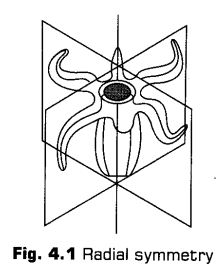
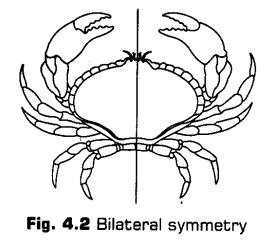
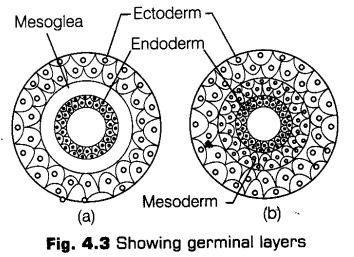
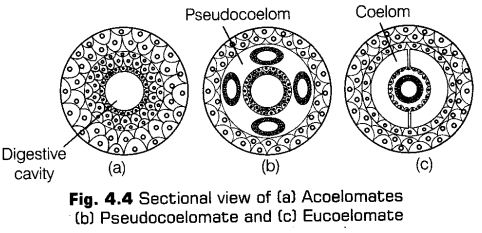
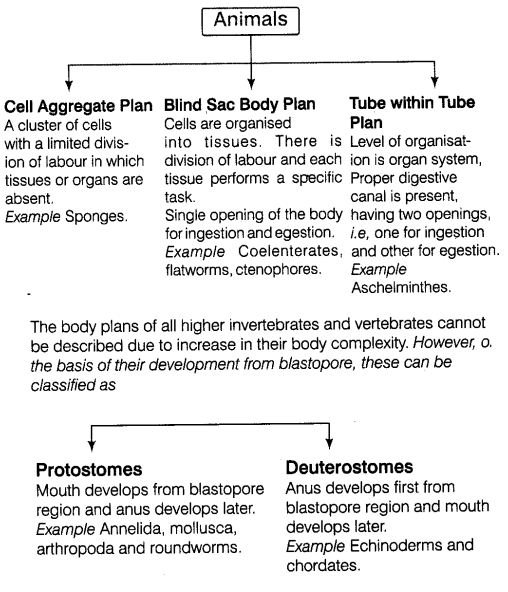
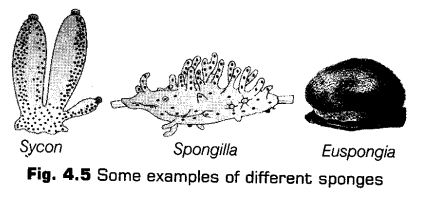
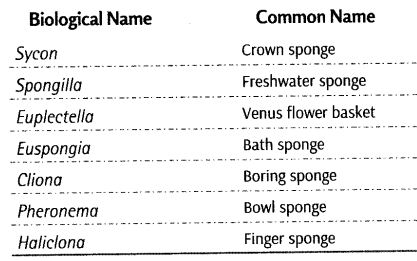
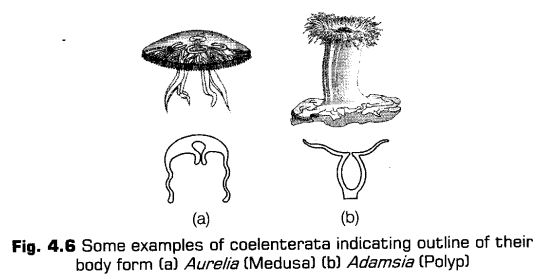
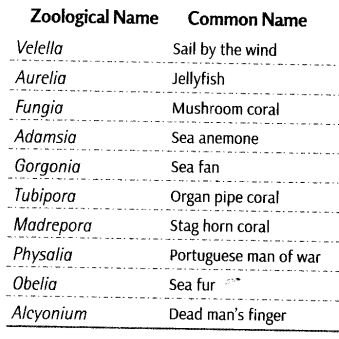
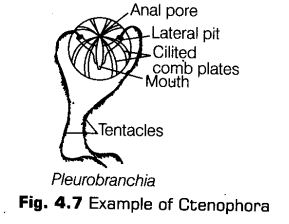
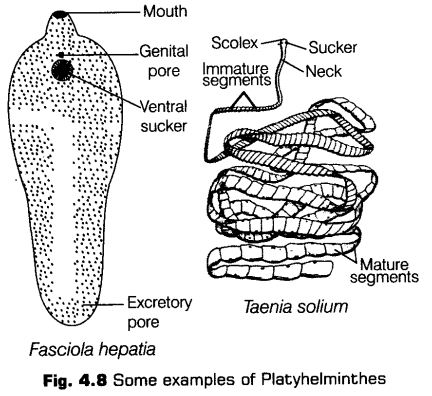
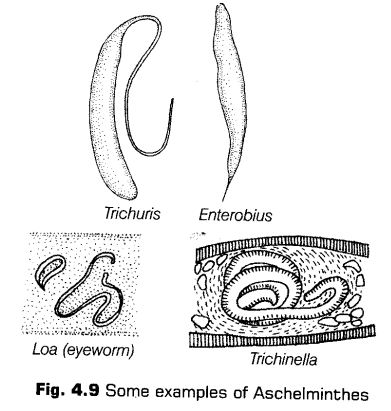
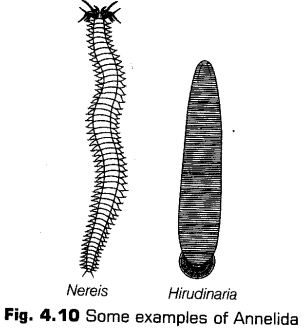
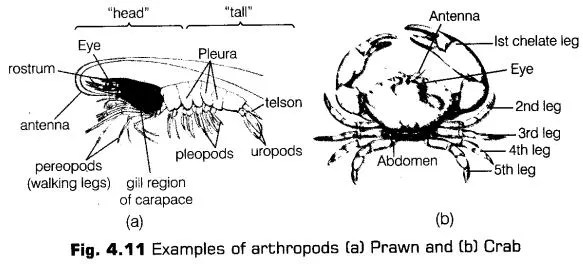
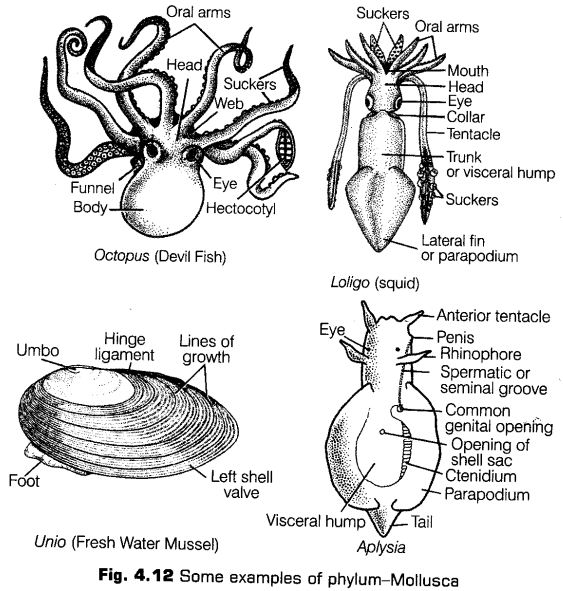
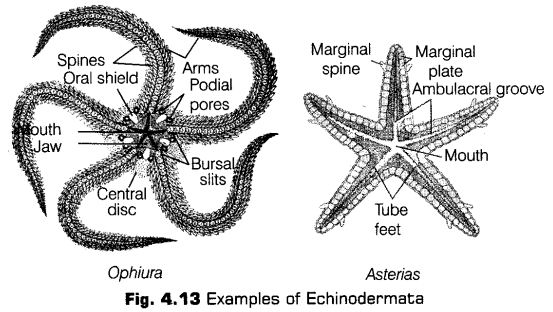
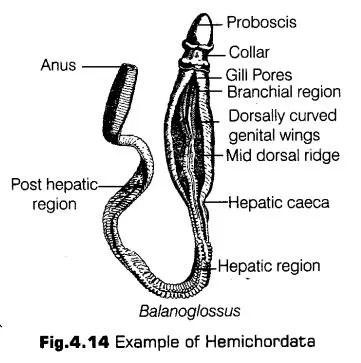
Leave a Reply